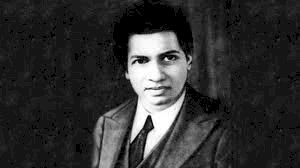Biography of Srinivasa Ramanujan
Srinivasa Ramanujan was born on December 22, 1887, in Erode, a small town in the Indian state of Tamil Nadu. Raised in a Brahmin family, he displayed an early fascination with mathematics, showing signs of prodigious talent by the age of 11.

Biography of Srinivasa Ramanujan
The Prodigy Mathematician Who Revolutionized Number Theory
Srinivasa Ramanujan was an Indian mathematician whose groundbreaking contributions to mathematical analysis, number theory, infinite series, and continued fractions have left an indelible mark on the field. Despite little formal training, Ramanujan’s intuitive grasp of complex mathematics led him to make profound discoveries that continue to influence mathematicians around the world. His story is one of extraordinary talent, perseverance, and dedication to the pursuit of knowledge.
Quick Info Section
- Full Name: Srinivasa Ramanujan Iyengar
- Born: December 22, 1887, Erode, Tamil Nadu, India
- Died: April 26, 1920, Kumbakonam, Tamil Nadu, India
- Field: Mathematics
- Notable Contributions: Ramanujan Prime, Ramanujan Theta Function, Mock Theta Functions
- Education: Mostly self-taught, with some study at the Government College in Kumbakonam
- Collaborations: Worked closely with British mathematician G.H. Hardy
- Honors: Fellow of the Royal Society (1918)
Early Life and Education
Srinivasa Ramanujan was born on December 22, 1887, in Erode, a small town in the Indian state of Tamil Nadu. Raised in a Brahmin family, he displayed an early fascination with mathematics, showing signs of prodigious talent by the age of 11. His formal education was often disrupted due to his singular focus on mathematics, neglecting other subjects, which eventually led to academic challenges.
Ramanujan studied at the Government Arts College in Kumbakonam, but his intense passion for mathematics took over, leading him to drop out. Despite lacking formal university education, he continued his mathematical pursuits independently, working through complex problems and developing his unique mathematical style.
Mathematical Discoveries and Contributions
Ramanujan’s most remarkable characteristic as a mathematician was his ability to intuitively understand highly advanced mathematical concepts. By the age of 16, he had thoroughly studied G.S. Carr’s Synopsis of Pure and Applied Mathematics, which provided the foundation for his early work. This book, along with his curiosity and genius, drove Ramanujan to develop original theories and formulas, many of which were previously unknown in mathematical literature.
Infinite Series and Number Theory
Ramanujan made significant advances in number theory, particularly with partition theory, which deals with the ways numbers can be expressed as sums of integers. He also made remarkable progress in understanding infinite series, producing results that amazed mathematicians for their depth and originality. His work on the Ramanujan prime and Ramanujan theta function continues to play a crucial role in modern mathematics.
Ramanujan-Hardy Collaboration
A major turning point in Ramanujan’s career came when he reached out to several mathematicians in England, including G.H. Hardy at Cambridge University. In 1913, Hardy recognized the brilliance of Ramanujan’s work and invited him to Cambridge, where they collaborated for several years. Together, they produced groundbreaking results, particularly in continued fractions, modular forms, and the analytic theory of numbers.
During his time in Cambridge, Ramanujan’s research flourished. He formulated new ideas, many of which were so complex that it took years for other mathematicians to fully understand and prove them. Hardy once remarked that Ramanujan’s mathematical insights were "profound and difficult," considering him one of the greatest mathematical talents of all time.
Challenges and Illness
Despite his academic success, Ramanujan faced several challenges. The cold English climate, combined with the difficulties of adjusting to a foreign culture, took a toll on his health. He contracted tuberculosis, which, coupled with malnutrition, weakened him over time. In 1919, Ramanujan returned to India in the hope of recovering, but his health deteriorated rapidly. He died on April 26, 1920, at the young age of 32, leaving behind a legacy of mathematical brilliance.
Legacy and Posthumous Recognition
Even after his death, Ramanujan’s work continued to impact mathematics. His notebooks, filled with thousands of formulas, were explored by mathematicians for decades. Many of his results were proven to be correct and paved the way for new areas of research, including string theory and black hole physics.
One of Ramanujan’s most famous contributions is the concept of mock theta functions, which have found applications in areas of mathematical physics. In 2012, a lost notebook of Ramanujan was discovered, leading to new research and further validation of his work.
Awards and Honors
Ramanujan was recognized during his lifetime for his contributions to mathematics. In 1918, he became one of the youngest Fellows of the Royal Society, a prestigious honor awarded to individuals who have made substantial contributions to scientific knowledge. He was also elected a Fellow of Trinity College, Cambridge, where he made significant progress in his research.
In 2011, National Mathematics Day was declared in India to be celebrated every year on December 22, his birthday, in recognition of his contributions to mathematics.
Influence on Modern Mathematics
Srinivasa Ramanujan’s contributions have had a lasting influence on various branches of mathematics. His ability to make intuitive leaps in complex areas of number theory continues to inspire mathematicians around the world. The Ramanujan Conjecture, which emerged from his work on modular forms, remains a central topic of research even today.
Conclusion
Srinivasa Ramanujan’s life is a testament to the power of raw genius and passion. His contributions to mathematics, made with little formal education, are a source of inspiration to mathematicians and scholars alike. Despite his short life, Ramanujan’s work has left an enduring legacy, and his discoveries continue to shape modern mathematical research.

 Deepak Maurya
Deepak Maurya 

































